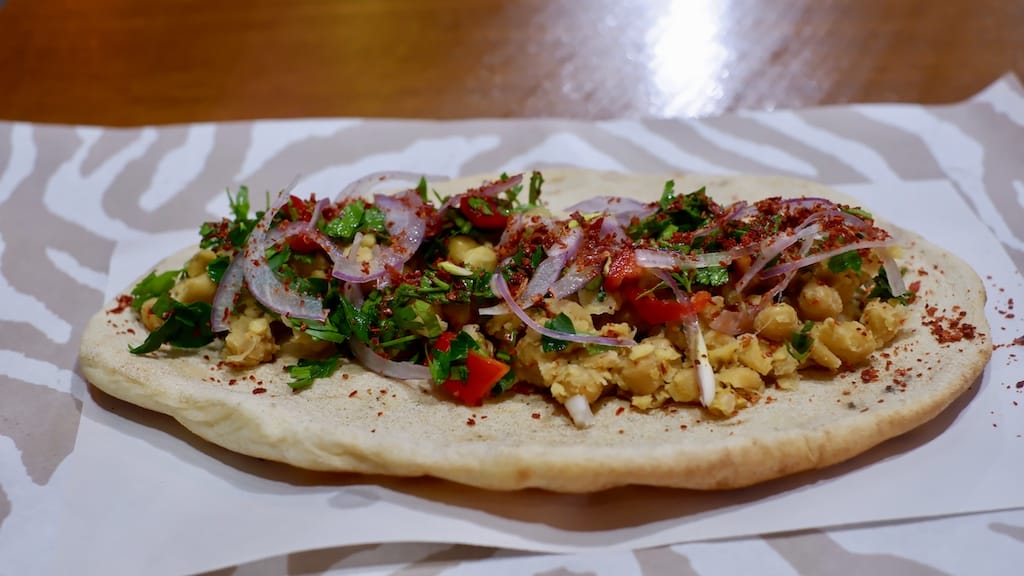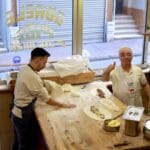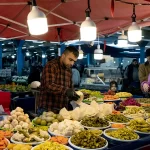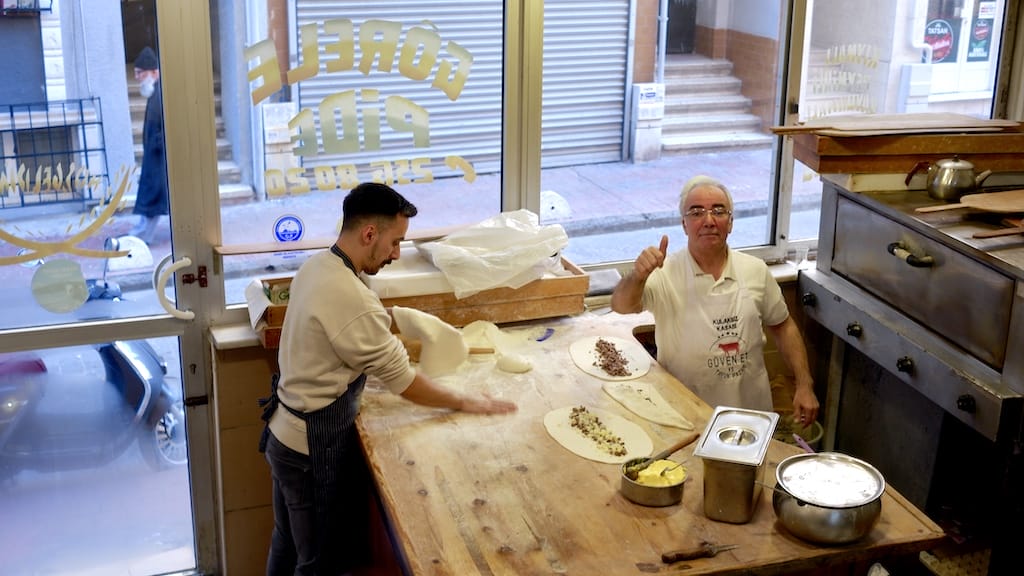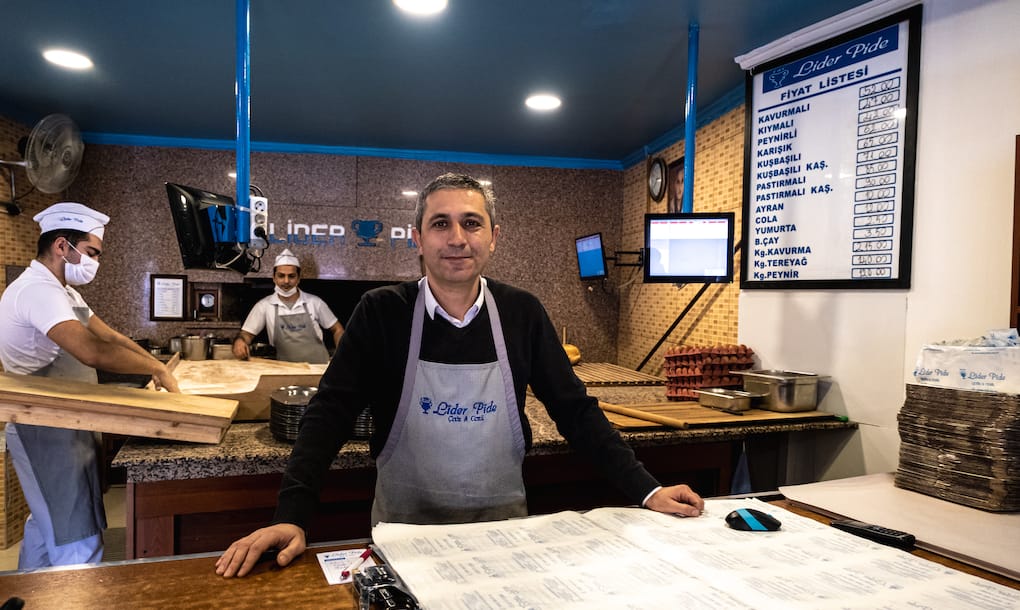Istanbul’s western suburb of Küçükçekmece is flanked by a small lake of the same name, the water of which flows from a river in the north and out into the Marmara Sea in the opposite direction. The coastline of the lake is just steps away from a train that stops at the foot of the Cennet neighborhood, where a hillside of ramshackle, single-story houses with gardens look out over the water. At the top of the hill, the neighborhood takes on a more modern character with six-story apartments and a bustling pedestrian avenue packed with cafes and restaurants.
Just off this street is a small eatery opened in 2022 by 35-year-old Ali Çapkın, a native of Turkey’s culinary capital of Gaziantep who has spent most of his life perfecting one of the specialties of his hometown: the humble yet deliciously flavorful nohut dürümü, a wrap of freshly-baked flatbread stuffed with soft, succulent chickpeas with chopped parsley, hand-cut fries, red onions, and red pepper flakes, served with a wedge of lemon and spicy peppers on the side.
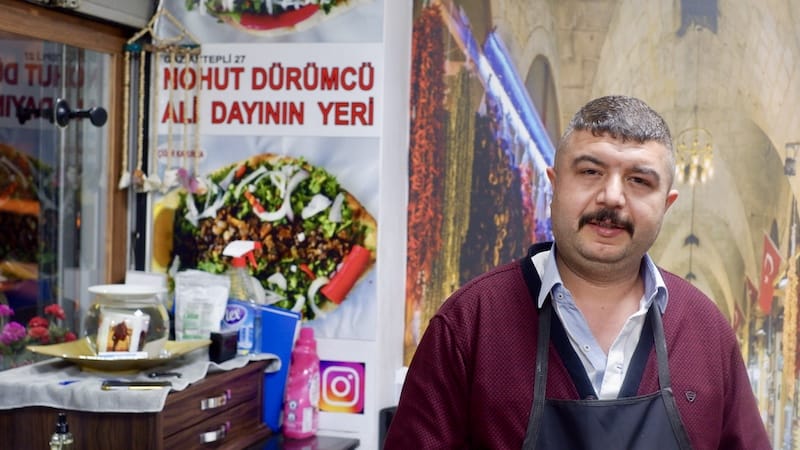
Better known as Ali Dayı (“Uncle Ali”), he started working at a beloved place serving the dish in Antep when he was 12 years old before coming to Istanbul as an 18-year-old. He later spent a decade alongside his nephews at Hamo’nun Yeri, a restaurant in the Güngören district’s neighborhood of Little Antep, which we wrote about in 2015 and have enjoyed many times since.
Ali Dayı eventually had a disagreement with his relatives and told them he planned on opening his own restaurant. They weren’t keen on this idea, but Ali Dayı opted for a location 15 kilometers to the west of Güngören in Küçükçekmece’s Cennet quarter, in order to not compete with his family. He has maintained the same top-notch quality, and is now on good terms with his nephews, who stopped by the shop the other day. As far as we know, Hamo’nun Yeri and Ali Dayı are the only two establishments in Istanbul specializing in this regional delicacy.
“[The chickpeas] are boiled in lamb bone broth,” he explains. “Some people around here try to make it at home but they can’t pull it off. These chickpeas have this kind of quality: if you cook them for a minute too long, they get crushed, but if you take them out two minutes early, they are tough and inedible.”
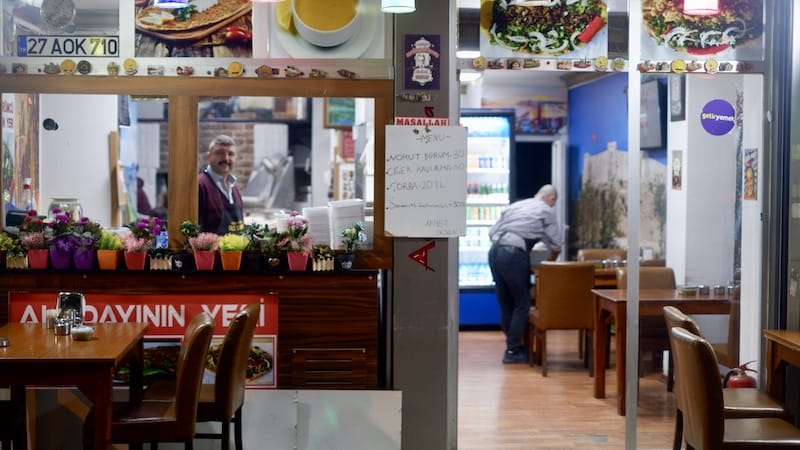
Though the secret ingredient renders what otherwise would be a completely plant-based dish off limits for herbivores, the bone broth adds a savory, bold flavor to the chickpeas, which are delightfully fluffy as if they are almost on their way to being ground into hummus. The parsley, fresh fries, and onions are welcomed toppings and we recommend a liberal douse of cumin and a fiery hot pepper or two for those so inclined. A cold, refreshing glass of ayran washes everything down well.
Also on the menu is roasted lamb liver, served in the same configuration, and just as tasty as we remember it at Hamo’nun Yeri. Ali Dayı built an oven in his place so he churns out small stacks of his fantastic tırnaklı ekmek bread as needed, in addition to preparing a Gaziantep-style lahmacun that we are curious to try, but have not yet had room for due to our penchant for the nohut dürümü.

“These dishes are known in Gaziantep as food eaten by poor people or those coming in from work and eating on their feet. But since we opened a shop here in Istanbul, the food has taken on a classier character. However, our prices are better than everywhere else,” he adds. Sure enough, a wrap full of chickpeas, roast liver, or a supple disc of lahmacun at Ali Dayı’s place are 30 TL ($1.60) a piece, which is less than one now pays in Istanbul for a standard chicken döner kebab that is considerably less tasty and healthy.
One wall of Ali Dayı’s restaurant is covered by an expansive photo of Gaziantep’s 2000-year-old fortress, which has been restored over the years and stood proudly in the center of the old city until February’s earthquakes, which resulted in large sections of the castle crumbling to the ground. It is somewhat eerie to look at the towering, bright image of the structure in all its glory after having seen its ruined state just a few weeks prior. Gaziantep fared better than some of the other cities in the region that were left practically unrecognizable, but it experienced significant trauma and destruction nonetheless.
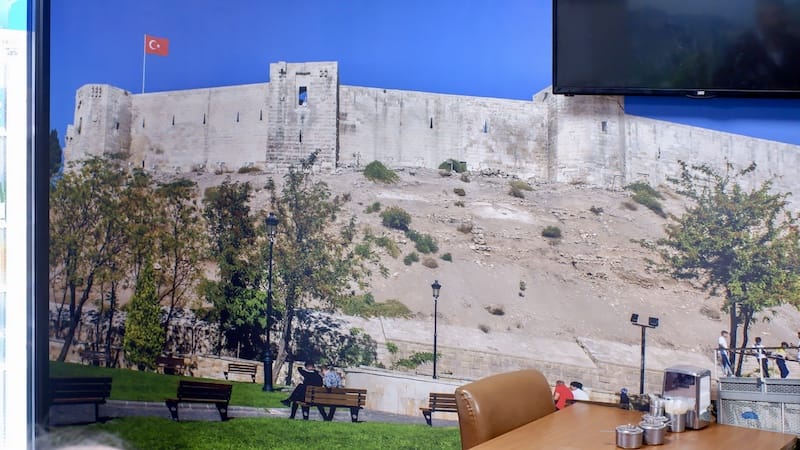
Though Ali Dayı has been busy behind the counter, the earthquake has affected him in no small way. His wife and children live in Gaziantep where they look after elderly relatives. When the earthquake struck, their home was damaged, so he quickly moved his family across the country. There are now 14 people staying in Ali Dayı’s small Istanbul apartment. He has donated a large sum of money to fund relief efforts and has given free food to dozens of earthquake victims who have settled in Istanbul.
“I won’t go broke because of 50 slices of bread, and I won’t get rich because of them either,” Ali Dayı said.
As we walked downhill through Cennet back to the train station, a long stretch of traffic edged around the glistening lake and just a handful of the innumerable high-rise buildings that dot Istanbul’s skyline loomed in the distance. Our bellies were full from the nohut dürümü and it was well worth the hour-plus journey it took to get to Küçukçekmece from the center of town, if such a place in Istanbul exists anymore.
We ambled through narrow streets where the small, informally-built homes and their adjacent gardens have managed to resist the wildfire of urban transformation. Like many places around town, this densely-populated suburb and its neighborhoods seem to lack rhyme or reason, but there is a thick energy cutting through the night sky, and we are once again reminded why we never get tired of exploring the endless opportunities this city has to offer.
Published on May 04, 2023
Related stories
March 26, 2024
IstanbulIn the steep hillside Kulaksız section of the Beyoğlu neighborhood, Şakir Sefer nimbly weaves dough stuffed with small piles of kıyma (ground beef) or strips of pastırma (cured, spiced beef) into the shape of a canoe before sending it into the flame-licked depths of a massive stone oven. It's after lunch rush but things are…
April 25, 2022
IstanbulRoaming the streets of Istanbul at 8:30 a.m. on a Sunday can be a surreal experience. The sun is shining, the seagulls are bellowing as they dip and dive – but the normally bustling streets are quiet. A few shops might be lifting their shutters, and cafés in younger neighborhoods may only just be putting…
March 30, 2022
IstanbulQuick bite: Far from the tourist trail, get a taste of one of the last bastions of classic Istanbul flavors, including bread fresh from the tandir oven, a mind-boggling assortment of meze, sizzling kebab, old school ice cream and much more. On this full-day food tour, we will dig deep into the culinary traditions of…







































